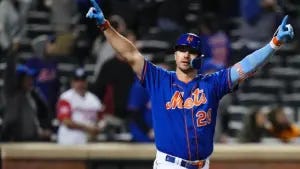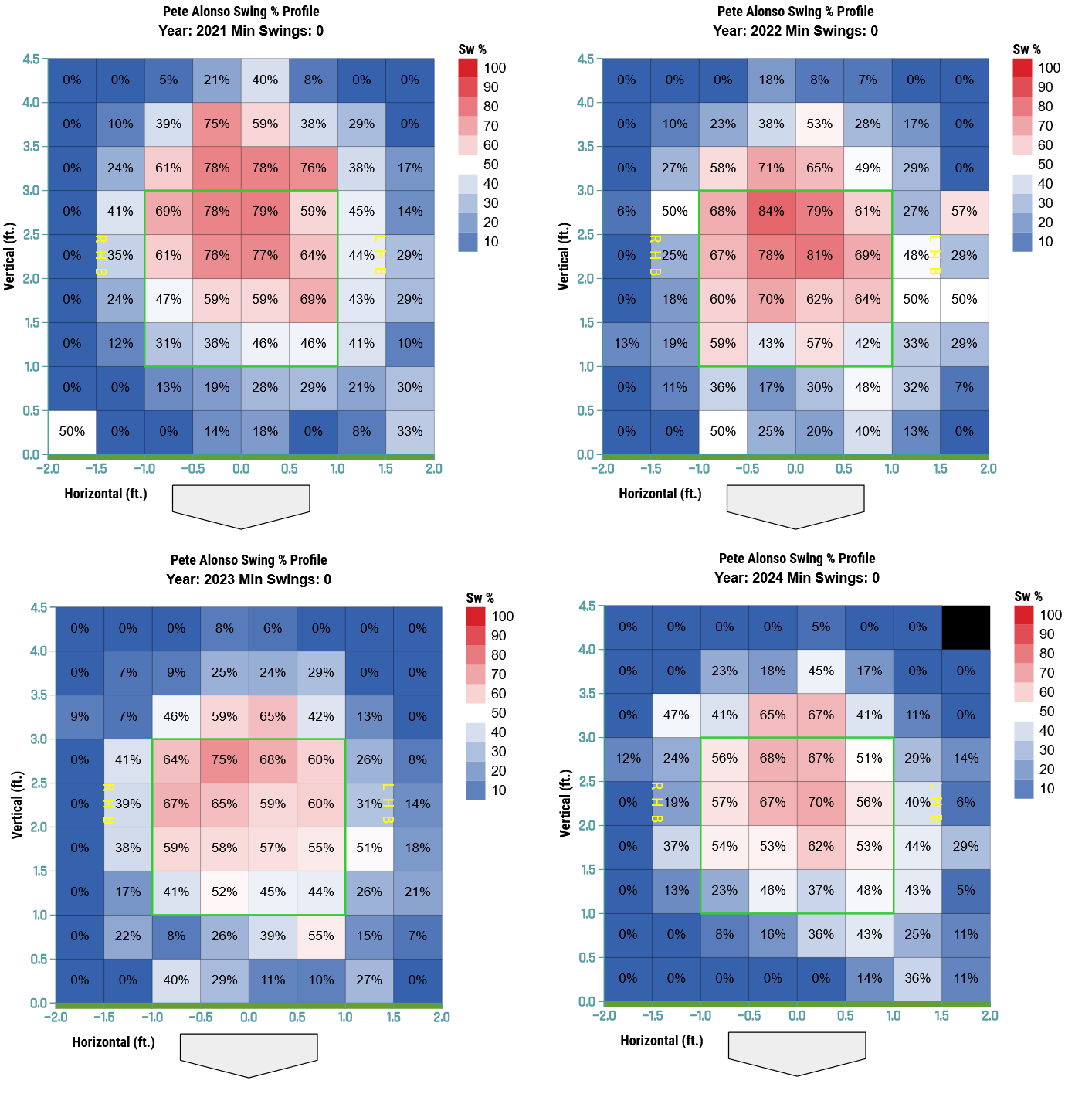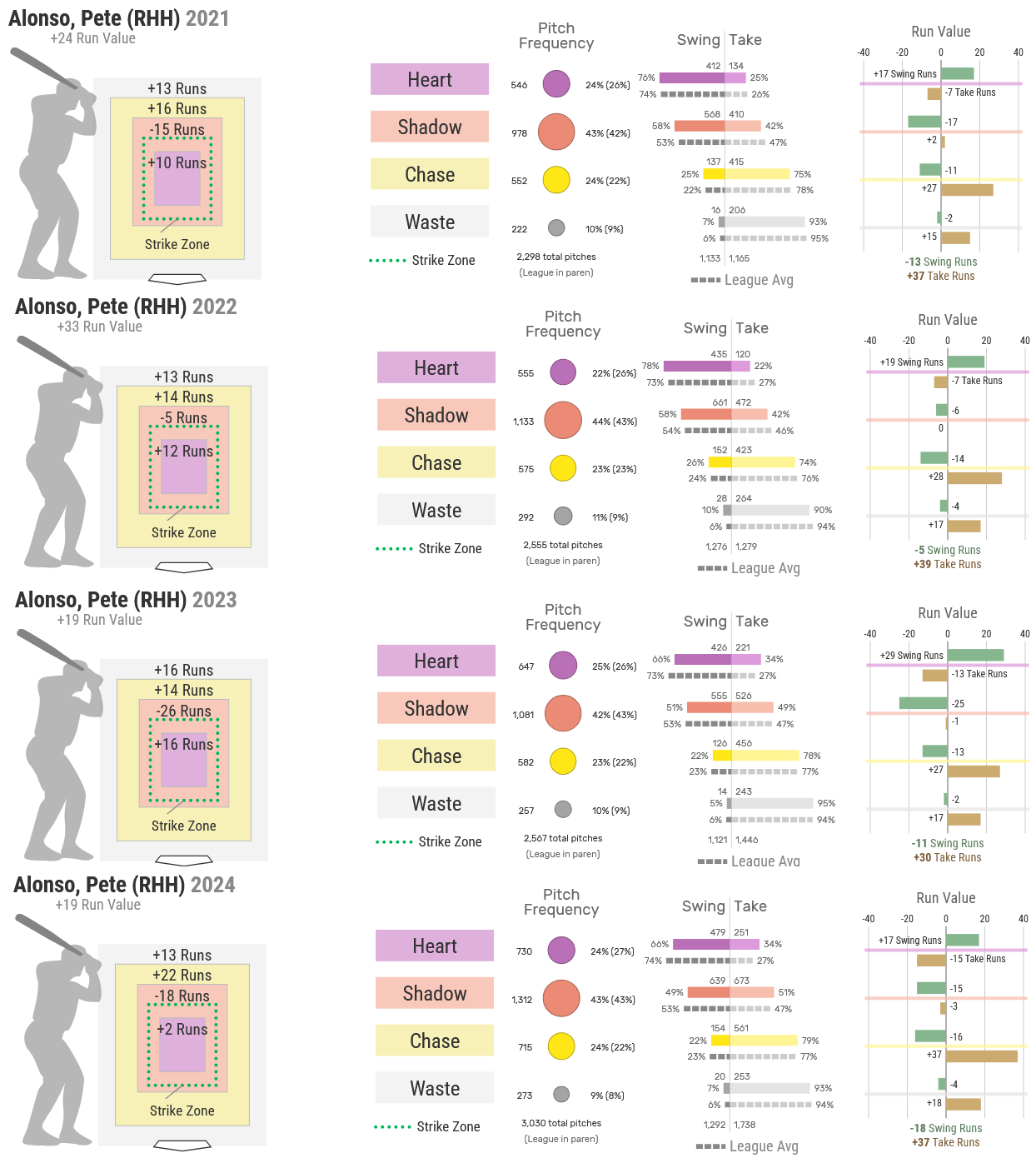The most frustrating and overwrought “will-they-or-won’t-they” since Ross and Rachel just may have been the one that played out this winter between the Mets and homegrown free agent Pete Alonso. The back-and-forth even had a made-for-TV ending wherein the parties in question, seemingly bucking the odds, ultimately reunited. The primary factor underpinning the dramatically lengthy courtship was, of course, the clear gap between what Alonso and the team believed to be fair compensation for his continued services both in years and dollars.
The standard line of reasoning was that Alonso’s vintage profile as a one-dimensional, slugging first baseman made him a poor long-term investment as he moved into his thirties. History has tended to the prove that reasoning fairly sound, all things considered. In fact, Alonso has seemingly started to get a somewhat early jump on following the downward aging curve associated with that profile by following up a stellar 2022 with two progressively worse performances during the 2023 and 2024 seasons.
There’s been plenty of digital ink dedicated to discussing how Alonso’s performance has declined over the past two seasons, but the why behind his early free fall remains unclear. His 2022 wRC+ of 141 was his highest since his 2019 rookie season, but he followed it up with a 20-point drop to 121 in 2023 and a slight uptick to 122 this past season. While his OBP and SLG have dipped and his strikeouts have increased considerably, many of the peripherals you might think to analyze for a player with his profile are relatively unchanged or haven’t changed consistently when comparing his 2023 and 2024 campaigns to his more successful 2022 output.
Peripheral statistics like barrels, hard hit rate, line drive rate, and the avalanche of stats now available for our perusal don’t seem to immediately highlight anything that consistently jumped out when assessing things we might typically associate with a power hitter in decline. With regard to the aging curve and expectations for critical power skills lost the Father Time, his bat speed in 2023 and 2024 was actually above the 90th percentile even if not at the top of the league.
His average exit velocity as compared to the rest of the league has continued to decline in the sense that he keeps falling into lower percentiles, but the raw numbers have remained fairly consistent throughout his career. His max exit velocity remains near the top of the league, and his ISO was actually significantly higher in 2023 (.287) than it was in 2022 (.246) before falling off of a cliff in 2024 (.219). His power seemed to be just fine in 2023 even though he was getting fewer hits, while he was getting more hits but for less power and driving in fewer runs in 2024. He’s absolutely not hitting the ball as hard as he once did on average, but it’s not so drastic as to definitively point to a slugger no longer slugging.
One aspect of his approach that does jump out over the last two seasons may indicate something that fans have regularly lamented, rightly or not, about Mets hitters in recent years: Alonso may have become too passive at the plate. According to his plate discipline metrics over at Fangraphs, Alonso’s Swing%, O-Swing% (pitches he swung at outside the strike zone), and Z-Swing% (pitches swung at inside the strike zone) all dropped fairly significantly in 2023 and 2024 when compared to most of the rest of his career. That Z-Strike% is of particular note as it coincides with an increase in called strikes against him (CStr%) over the last two seasons.
According to Statcast plate discipline metrics at Baseball Savant, he also swung at “meatballs” almost 20% less often in 2023 when compared to 2022 despite seeing more of them. You’ll also notice that he swung at noticeably fewer first pitches in 2023 and 2024 despite seeing a relatively consistent number of first pitch strikes across his career, presumably getting himself into early holes more often.
His swing profile is just as telling with regard to the choices he’s made in 2023 and 2024 when compared to earlier seasons.
The charts above, courtesy of Baseball Savant, show a reduction in his swing percentages generally and particularly in the upper half of the zone and just above it. This trend is also evident in the Baseball Savant charts below that quantify the run outcomes that resulted from his choices to swing or take a pitch in the various regions surrounding the plate.
The above chart provides another visual demonstration of the marked change in Alonso’s swing profile as we can observe that his Swing/Take percentages have shifted to the “take” side in 2023 and 2024 for the “Heart” and “Shadow” regions. He actually took the pitches in these regions more often than the league average in 2023 and 2024, while the opposite was true in 2021 and 2022. We can also see the negative impact the lack of swinging in those regions had on the run values on the right side of the charts for the 2023 and 2024 seasons. The underlying numbers appear to point to a hitter, purposefully or not, that may have aimed for additional patience but instead landed on counterproductive passivity.
There may also be another wild card that’s worth considering as a contributing factor to the fairly substantial change to Alonso’s approach at the plate, though. There’s a stat called “Pace” at the far right of the Fangraphs plate discipline chart that I linked to above, which highlights the time that a batter has between pitches. Alonso had almost eight fewer seconds between pitches in 2023, when the pitch clock was introduced, when compared to 2022. He lost another second during the 2024 season. It should be noted that the pitch clock wasn’t just a huge adjustment for pitchers.
Has Alonso modified his approach to the point that he’s not aggressive enough at the plate, particularly considering his role as a slugger? Has the pitch clock completely thrown him off to the point that he’s no longer quite prepared by the time the ball is hurtling his way? Is it a combination of both?
The reunion between the Mets and Alonso ensures that we get at least one more season to see if this is his new normal, though it’s certainly telling that the team was determined in their intent to avoid a long-term commitment.







Great but overwhelming stats and charts with this article. Passive could be applied to many players who just take strike one like it is expected. There were some games this past season where the Mets came out swinging versus trying to run up the pitch count and that produced some quick runs giving them a leg up from the start. I’d like the whole team to be more aggressive at the plate given that we all grew up with the notion that pitchers who throw strike one from the start and go up 0-1 in the count have an advantage. How many times did we lament in the game chatter about Alonso swinging at the low and outside pitch that a high school player would lay off? While his hitting has declined the last few years, no one seems so upset about declining batting averages because there are some many other metrics that they say are more telling about how a batter is doing. And it appears that when some of the other metrics are okay, that increased strikeouts are brushed aside. Kyle Schwarber batted .197 with 215 Ks in 2023 but that was okay because of his power numbers that produced 47 HR but only 104 RBI. When you hit so many long balls the need to play small ball, something the Mets did well in 2024, becomes lost in the shuffle.
My take is that the declining average and increased strikeouts tells a story of a player that is not getting hits or moving the runners along and therefore it results in less runs scored. This could have less to do with a players decline versus a coaching staff that is missing the boat. These days a player gets back to the dugout and looks at their at bat on a tablet. Either they are blind or refusing to change their approach to hitting. We also hear that players work countless hours in the batting cage to correct flaws but often do not see improvement on the field. Some of that must be attributed to decline, and some to refusal to change an approach and some to poor coaching.
Another factor in a batter’s success is how the players around them are hitting. While the notion of having someone behind you to protect you appears to have much less impact in reality, it still seems that if players behind you in the order are not performing well then you will get fewer good pitchers to hit. This notion will be put to the test this year if Alonso slots in the three hole and then has Nimmo, Vientos and Alvarez batting after him.
So I agree with the need for Alonso to become less passive and be more ready to attack the ball. It would also be helpful if he can lay off the low and outside pitch and has a more aggressive approach at the plate that would have him swinging at more pitches over the plate. Can’t imagine standing in against a 96 MPH fast ball, let alone being able to swing and hit it in the split second after it leaves the pitchers hand. But that’s what separates the pros from us mere mortals and why they make more in a game then most of us make in a year.
Looking for a bounce back year from Pete and a huge increase in RBI. I’d accept 35-40 HR if he becomes a better run producer and while statistically he does not rank in the top of the first base fielders, you have to still appreciate the way he digs balls out of the dirt that saves countless errors and runs. If he has a monster season and the Mets win it all, it will be interesting whether the Mets sign him to a three year extension, or say thanks Pete, we still think you’re heading into your declining 30’s. I guess the opt out serves both parties and puts the onus on Alonso to step up, something he did more in the playoffs when it really counted than in the regular season.
Excellent article. I believe the answer to the title of the article is yes. Because of an article that I saw a while back about plate appearance results with first pitch swinging, I have been doing some additional research on that topic. The evidence is there that the pitchers have the upper hand when they can throw strike one without worrying much about the hitter swinging at it. All pitches are not created equally. Although not a Met, Brent Rooker of the A's is a guy that changed his first pitch swinging approach with great positive results.
I knew that Pete was not particularly aggressive on pitch 1, but I had not thought of time-clock aspect of it. It certainly looks like Pete might need to make some adjustments.
Great stuff! Thanks!